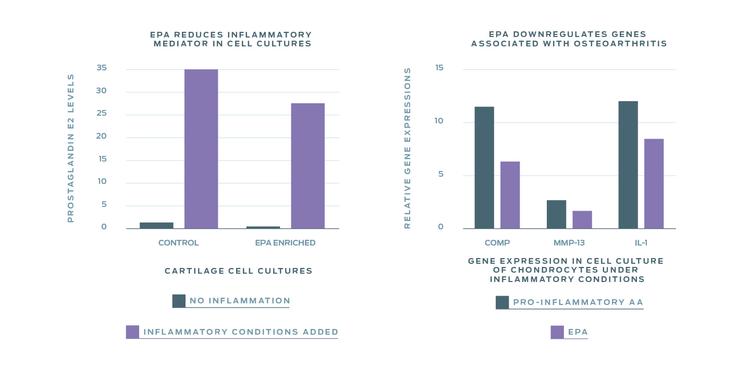
RNA
In order for cells to carry out the instructions encoded in DNA, genes are first transcribed, or copied, into RNA. Although every cell has the same DNA, each cell type expresses only the genes needed to perform its job.
Collecting and comparing RNA transcripts under varied health conditions provides clues about cell functions. Osteoarthritis (OA) is one pet health condition where Purina scientists used transcriptomics to better understand a disease and discover nutritional solutions that could improve outcomes for dogs with this condition.
Purina's research


Purina’s scientists used transcriptomics to identify eicosapentaenoic acid (EPA) as an optimum type of omega-3 fatty acid that could decrease inflammatory mediators and downregulate cartilage-degrading enzymes.


In dogs with naturally occurring knee injuries that were fed the EPA-enriched diet, synovial fluid analysis showed chondrocytes were bathed in EPA at previously identified protective levels. Results also confirmed reductions in cartilage-damaging enzymes.3

In another study, arthritic dogs fed a diet with an optimal nutrient blend, including EPA, showed client-perceived positive behavioral changes and a 6.9% improvement in mobility.4
Key things to remember
- Comparing RNA transcripts of pets under varied health conditions enables researchers to find changes in gene activity that may contribute to disease or respond to dietary management.
- Purina’s research identified hundreds of transcripts that differed between OA and healthy joints, such as upregulated cartilage-degrading enzymes in dogs with OA.
- Transcriptomics helped to identify EPA as an optimum omega-3 fatty acid that could decrease inflammatory mediators and downregulate cartilage-degrading enzymes.
Find out more
1. Middleton, R.P., Hannah, S. S., Perroud, B. N., & McDonald, K. K. (2003). Gene expression profiling of osteoarthritis from canine chondrocytes. The development of a canine OA microarray chip. Poster session presented at the 49th meeting of the Orthopaedic Research Society, New Orleans, LA.
2. Holzwarth, J.P., Middleton, R. P., Roberts, M., Mansourian, R., Raymond, F., & Hannah, S. S. (2005). The development of a high-density canine microarray. Journal of Heredity, 9, 817–820.
3. Hansen, R. A., Harris, M. A., Pluhar, G. E., Motta, T., Brevard, S., Ogilivie, G. K., & Allen, K. G. D. (2008). Fish oil decreases matrix metalloproteinases in knee synovia of dogs with inflammatory joint disease. Journal of Nutrition, 19, 101–108. doi:10.1016/j.jnutbio.2007.01.008
4. Moreau, M., Troncy, E., del Castillo, J. R., Bédard, C., Gauvin, D., & Lussier, B. (2013). Effects of feeding a high omega-3 fatty acids diet in dogs with naturally occurring osteoarthritis. Journal of Animal Physiology and Animal Nutrition, 97, 830–837.